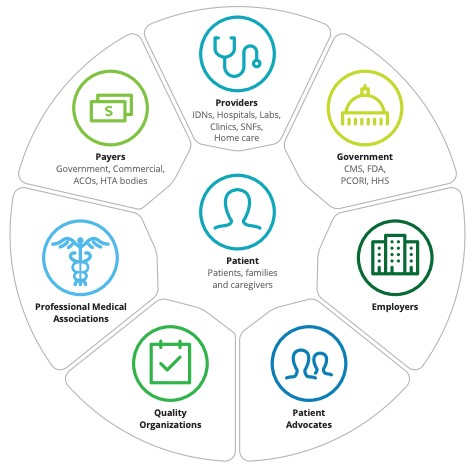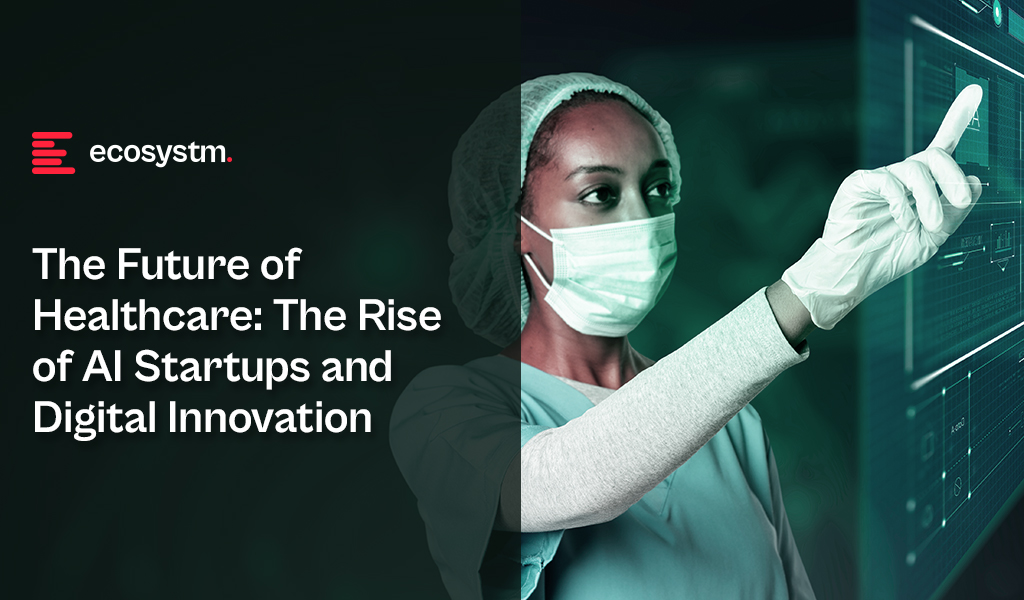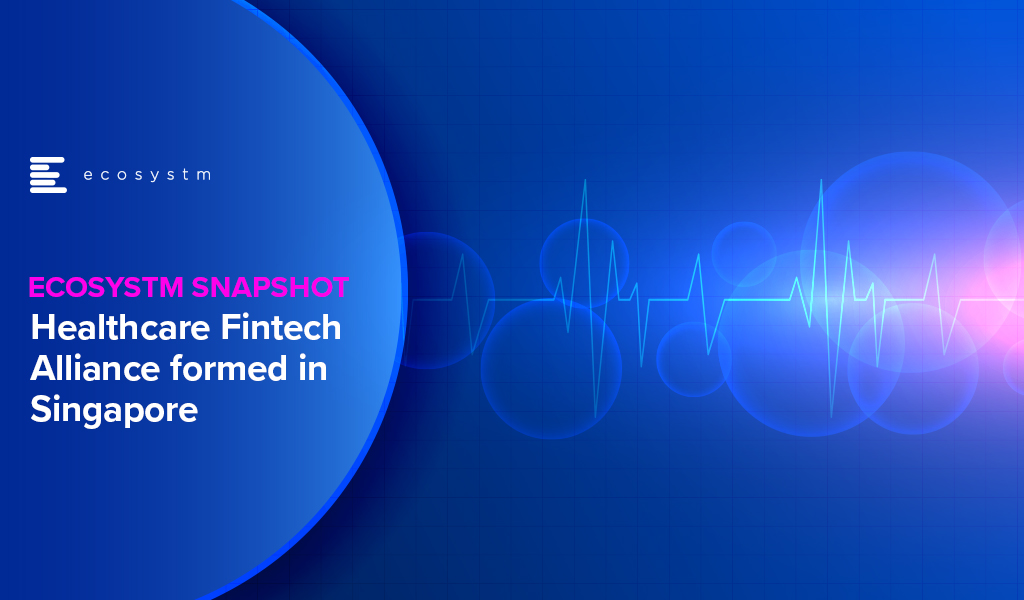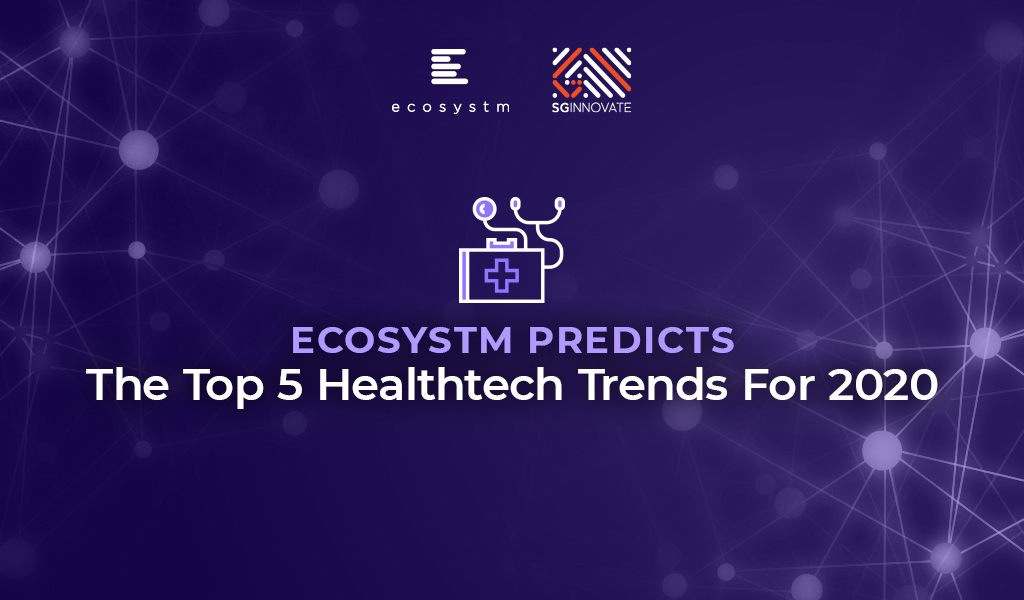Healthcare delivery and healthtech have made significant strides; yet, the fundamental challenges in healthcare have remained largely unchanged for decades. The widespread acceptance and integration of digital solutions in recent years have supported healthcare providers’ primary goals of enhancing operational efficiency, better resource utilisation (with addressing skill shortages being a key driver), improving patient experience, and achieving better clinical outcomes. With governments pushing for advancements in healthcare outcomes at sustainable costs, the concept of value-based healthcare has gained traction across the industry.
Technology-driven Disruption
Healthcare saw significant disruptions four years ago, and while we will continue to feel the impact for the next decade, one positive outcome was witnessing the industry’s ability to transform amid such immense pressure. I am definitely not suggesting another healthcare calamity! But disruptions can have a positive impact – and I believe that technology will continue to disrupt healthcare at pace. Recently, my colleague Tim Sheedy shared his thoughts on how 2024 is poised to become the year of the AI startup, highlighting innovative options that organisations should consider in their AI journeys. AI startups and innovators hold the potential to further the “good disruption” that will transform healthcare.
Of course, there are challenges associated, including concerns on ethical and privacy-related issues, the reliability of technology – particularly while scaling – and on professional liability. However, the industry cannot overlook the substantial number of innovative startups that are using AI technologies to address some of the most pressing challenges in the healthcare industry.
Why Now?
AI is not new to healthcare. Many would cite the development of MYCIN – an early AI program aimed at identifying treatments for blood infections – as the first known example. It did kindle interest in research in AI and even during the 1980s and 1990s, AI brought about early healthcare breakthroughs, including faster data collection and processing, enhanced precision in surgical procedures, and research and mapping of diseases.
Now, healthcare is at an AI inflection point due to a convergence of three significant factors.
- Advanced AI. AI algorithms and capabilities have become more sophisticated, enabling them to handle complex healthcare data and tasks with greater accuracy and efficiency.
- Demand for Accessible Healthcare. Healthcare systems globally are striving for better care amid resource constraints, turning to AI for efficiency, cost reduction, and broader access.
- Consumer Demand. As people seek greater control over their health, personalised care has become essential. AI can analyse vast patient data to identify health risks and customise care plans, promoting preventative healthcare.
Promising Health AI Startups
As innovative startups continue to emerge in healthcare, we’re particularly keeping an eye on those poised to revolutionise diagnostics, care delivery, and wellness management. Here are some examples.
DIAGNOSTICS
- Claritas HealthTech has created advanced image enhancement software to address challenges in interpreting unclear medical images, improving image clarity and precision. A cloud-based platform with AI diagnostic tools uses their image enhancement technology to achieve greater predictive accuracy.
- Ibex offers Galen, a clinical-grade, multi-tissue platform to detect and grade cancers, that integrate with third-party digital pathology software solutions, scanning platforms, and laboratory information systems.
- MEDICAL IP is focused on advancing medical imaging analysis through AI and 3D technologies (such as 3D printing, CAD/CAM, AR/VR) to streamline medical processes, minimising time and costs while enhancing patient comfort.
- Verge Genomics is a biopharmaceutical startup employing systems biology to expedite the development of life-saving treatments for neurodegenerative diseases. By leveraging patient genomes, gene expression, and epigenomics, the platform identifies new therapeutic gene targets, forecasts effective medications, and categorises patient groups for enhanced clinical efficacy.
- X-Zell focuses on advanced cytology, diagnosing diseases through single atypical cells or clusters. Their plug-and-play solution detects, visualises, and digitises these phenomena in minimally invasive body fluids. With no complex specimen preparation required, it slashes the average sample-to-diagnosis time from 48 hours to under 4 hours.
CARE DELIVERY
- Abridge specialises in automating clinical notes and medical discussions for physicians, converting patient-clinician conversations into structured clinical notes in real time, powered by GenAI. It integrates seamlessly with EMRs such as Epic.
- Waltz Health offers AI-driven marketplaces aimed at reducing costs and innovative consumer tools to facilitate informed care decisions. Tailored for payers, pharmacies, and consumers, they introduce a fresh approach to pricing and reimbursing prescriptions that allows consumers to purchase medication at the most competitive rates, improving accessibility.
- Acorai offers a non-invasive intracardiac pressure monitoring device for heart failure management, aimed at reducing hospitalisations and readmissions. The technology can analyse acoustics, vibratory, and waveform data using ML to monitor intracardiac pressures.
WELLNESS MANAGEMENT
- Anya offers AI-driven support for women navigating life stages such as fertility, pregnancy, parenthood, and menopause. For eg. it provides support during the critical first 1,001 days of the parental journey, with personalised advice, tracking of developmental milestones, and connections with healthcare professionals.
- Dacadoo’s digital health engagement platform aims to motivate users to adopt healthier lifestyles through gamification, social connectivity, and personalised feedback. By analysing user health data, AI algorithms provide tailored insights, goal-setting suggestions, and challenges.
Conclusion
There is no question that innovative startups can solve many challenges for the healthcare industry. But startups flourish because of a supportive ecosystem. The health innovation ecosystem needs to be a dynamic network of stakeholders committed to transforming the industry and health outcomes – and this includes healthcare providers, researchers, tech companies, startups, policymakers, and patients. Together we can achieve the longstanding promise of accessible, cost-effective, and patient-centric healthcare.

We are in the midst of an economic and social crisis. COVID-19 will have far-reaching effects on organisations and how they do business. It is expected to drive more investments in Fintech, especially in digital payments, as more organisations and consumers adopt eCommerce. Countries will also have to re-think the ways they trade with other countries, as travel restrictions continue. This is expected to boost the Fintech industry and July was witness to how Fintech organisations, financial institutions and governments are gearing up to leverage Fintech in their path to economic and social recovery.
Financial Industry Seeing More Open Banking Initiatives
The banking industry is fast moving towards collaboration and openness. July saw several initiatives that take the industry closer to open banking.
Late last year, South Korea piloted an open banking system with participation from local banks and lenders. The Financial Services Commission (FSC), South Korea’s top financial regulator reported in July that the initiative had participation from 72 companies including commercial banks and Fintech firms with 20 million subscribers using the open banking services.
Australia introduced an open banking initiative, monitored by the Australian Competition and Consumer Commission (ACCC). From July, Australia’s banking customers can share their financial and banking data with accredited businesses under Consumer Data Right Act to access a better suite of financial applications.
There is global expansion as well. Railsbank, a global open banking platform with a presence in Southeast Asia introduced their services in the US market. The company will offer Banking-as-a Service, Cards-as-a Service and Credit Card-as-a-Service in the US market. Khaleeji Commercial Bank (KHCB), an Islamic bank in Bahrain, launched their open banking service enabling a customer to link their bank accounts with other banks and manage through the ‘Khaleeji 360’ platform. The portal allows clients to view all their bank accounts, automate operations and conduct banking through a unified platform.
Financial Institutions Increasing Partnerships with Fintech
Financial institutions no longer look at Fintech as competition. They appreciate that customers are at the centre of their entire operation – and Fintech services can and will provide them with the solutions they need. As financial institutions re-think their transformation journeys and face increasingly stringent regulations, they no longer have the option of ignoring Fintechs.
American Express, Visa, Mastercard and Discover came together to roll out a global standard. The big four’s advanced digital checkout solution Click to Pay is an online checkout system based on EMV Secure Remote Commerce (SRC) to make online payments across websites, mobile applications and connected devices, frictionless.
With an aim to unify payment solutions, a group of 16 major European banks launched the European Payment Initiative (EPI) to create a unified pan-European payment solution leveraging Instant Payments/SEPA Instant Credit Transfer (SCT Inst), including a card, e-wallet and P2P payments.
We also saw financial institutions strengthen their cross-border payment services in July. Deutsche Bank partnered with Airwallex to offer virtual account collections and API-enabled foreign exchange services in Japan and Hong Kong. The service will enable merchants and traders to transact through virtual accounts and APIs without opening bank accounts in foreign markets. Mastercard and Bank of China partnered to enhance cross-border business payments into China. This will enable global businesses to send payments to China while accessing real-time exchange rates, reduce the need for unnecessary documentation between merchants, and reduce transaction hassles and costs.
Fintechs Facilitating Cross-border Trade
Seamless cross-border financial transactions will be key to economic recovery, whether easy remittance or the ability to reach a larger market and be able to trade beyond borders.
July saw the formalisation of the Digital Economy Partnership Agreement (DEPA) between New Zealand, Chile and Singapore, to facilitate end-to-end digital trade, which includes establishing digital identities, paperless trade and the development of Fintech solutions to support it. The initiative also intends to allow cross-border data flow and give access to necessary government data to small and medium enterprises (SMEs) enabling them to be digital-ready to explore newer markets.
Dubai International Financial Centre (DIFC) signed an MoU with Jiaozi Fintech Dreamworks based in China opening new opportunities for innovation and trade. The agreement will enable Fintech companies based in both cities to access each other’s markets. Primarily established to facilitate the ‘Belt and Road’ initiative, it is a critical component of the DIFC’s 2024 strategy to strengthen relationships with the international financial community and increase access to the South-South corridor. Over the last few years, DIFC has been associated with over 200 Fintech organisations, and last month invested in four Fintech startups through their accelerator program. The agreement with Jiaozi will look at collaboration opportunities in Blockchain, AI and Cloud and will facilitate cross-border workshops and training programs.
Continuing Interests in Emerging Economies
Fintechs have been a means to bring about financial inclusion and are increasingly being used to target the unbanked and underbanked. Emerging economies continue to be attractive for Fintech organisations and global financial institutions.
With much of Malaysia’s economy dependent on foreign workers, Instapay, regulated by the Bank Negara Malaysia (BNM), announced a collaboration with Mastercard, to provide e-wallet accounts to the migrant workers. The widespread use of e-wallets by the migrant worker community will bring benefits to both workers, as well as their employers. Interestingly, Fintech providers in emerging economies are also looking to expand into other emerging markets. Malaysia’s GHL Group received approval from Philippines Securities and Exchange Commission to operate a lending business through their new unit, GHL Philippines Financing Services. GHL has been diversifying its business and has been operating its lending business in Malaysia and Thailand since 2019.
Crown Agent Bank, a wholesale foreign exchange and cross-border payment services based in the UK, partnered with South Africa’s biometric-based payment company, Paycode. Together the companies are aiming to reach 100 million unbanked customers where Crown Agents Bank will use their FX and payment services to bolster Paycode’s product offering and support financial inclusion across Sub-Saharan Africa.
India and Indonesia in the Asia Pacific continue to be popular markets because of the huge proportion of the unbanked population. Rapyd, a UK based global B2B Fintech-as-as-service provider partnered with major Indian e-payment providers – including Paytm, PhonePe, PayU, Citibank, DBS Bank, HDFC Bank, BharatPay, and Unimoni to launch an all-in-one payments solution that spans credit and debit cards, UPI, wallets, and cash. New registrations for digital banking in Indonesia are on the rise and Fintech startup Akulaku is capitalising on the potential digital banking overhaul to offer affordable and comprehensive financial services to consumers.
Fintechs benefiting other industries
The Fintech revolution has shown the path to several other industries – Healthcare and Agriculture are some of the industries that are hoping to benefit from Fintech organisations and their innovations. The MoU between Alibaba Cloud, Pfizer and Singapore’s Fintech Academy announced earlier in July, promises to give early and necessary guidance to Healthtech start-ups, and shows the deep connection between Healthtech and Fintech. In the Philippines, in an effort to improve financial services for farmers, AgriNurture acquired Fintech firm Pay8. By leveraging Pay8 e-wallet services, farmers will be able to access online payment services. This will enable the largely unbanked farmer community to become an active part of the economy.
The technology that these industries are looking to benefit from is Blockchain. South Korea brought Blockchain to their healthcare industry for better data management and storage. The 3 major telecommunications providers in the country – KT, SK Telecom and mobile carrier LG U+ – have also collaborated with KB Insurance to launch the blockchain-based mobile notification service (MNS) by matching customer data to their mobile subscription information. Oxfam Ireland – a charity organisation based in Ireland, received a sum of USD 1.18 million from the European Commission for a Blockchain-based pilot. The company is working on a project -The UnBlocked Cash – to help disaster-affected communities receive cash-based entitlements with more efficiency and traceability.
Fintech will continue to be a cornerstone of economic and social recovery in the future, and the financial industry will see more collaborations between Fintech organisations, financial institutions and governments. Other industries will continue to take learnings from Fintech.

In the report, Ecosystm Predicts: The Top Healthcare Trends for 2020, we had noted the similarities between the healthcare and the financial services industries and that Healthtech will take lessons from the Fintech industry.
In the report, Ecosystm Principal Analyst, Sash Mukherjee said, “Fintech plays a significant role in driving greater inclusion, especially to drive the induction of the unbanked into the mainstream economy, give the underbanked more options to leverage the broader financial services available, and reduce disparity in the adoption of financial services by bridging the gender gap and differences based on ethnicity and socio-economic status. It is not hard to imagine a similar fate for Healthtech. As the industry focuses on value-based outcomes, governments put in more regulations around accountability and transparency in the industry, and people expect the customer experience that they get out of their retail interactions, Healthtech start-ups will become as mainstream as Fintech start-ups.”
However, Mukherjee notes that there might be some pitfalls in this journey, especially when organisations focus more on the technology and less on the actual application and benefits of the technology. “Innovators and start-ups need to align themselves early, with corporates and technology providers to gain a better understanding of the market and regulatory landscape.”
Singapore bringing key industry stakeholders together
The MoU between Alibaba Cloud, Pfizer and Singapore’s Fintech Academy announced yesterday, is a move in the right direction that promises to give early and necessary guidance to Healthtech start-ups. Under the newly formed Healthcare Fintech Alliance (HFA), Alibaba will provide infrastructural support and technological mentorship to the Healthtech and Fintech start-ups to help them leverage cloud, AI and other technologies for their future requirements. The Fintech Academy will guide these start-ups through talent management and venture building programs. Pfizer will provide thought leadership through its network of healthcare experts and opinion leaders, including guidance on commercialisation of the products and services. The Healthcare Fintech Alliance initiative will begin with a pilot in Singapore, Indonesia, and Vietnam before expanding to other regions – Malaysia and the Philippines.
Mukherjee says, “The healthcare industry, for all the cutting-edge research, that it represents, has been remarkably slow to transform. But the COVID-19 crisis has forced the industry to transform, without the luxury or time to think about it. While the implications on the life sciences and provider organisations is clearer, there has simultaneously emerged a need for transformation in the healthcare payer industry. There will be greater demand from consumers for micro-financing to tide over sudden healthcare crises and greater transparency in how these funds are managed. Again, there is an immense potential here for the industry to learn from Fintech.”
Healthcare Fintech Alliance Focus Areas
The focus areas for Healthcare Fintech Alliance shows the deep connection between Healthtech and Fintech.
- Healthcare Affordability. Micro-financing and other financial models involving patients, family members, payers, and other healthcare stakeholders
- Value Based Healthcare. Linking payment schemes to a drug’s effectiveness, health outcomes or utilisation
- Outcome Monitoring. Tracking and reporting of outcomes derived from patients, wearables, healthcare providers, R&D databases and real-world evidence.
- Personalised Healthcare. Using digital technology to tailor healthcare to individual needs
- Innovative Healthtech Devices. Driving adoption in digital tools, such as diagnostic tools linked to medicine access and reimbursement
- Population Health Management. Leveraging patient and associated data in a compliant way to better understand population health characteristics, for effective wellness programs, treatment protocols and cost management.
“Alliances such as these have potential benefits for the industry stakeholders such as Alibaba and Pfizer. Alibaba has been focusing on the Southeast Asia market – earlier in the month the Alibaba Cloud Philippines Ecosystem Alliance was formed to support digital transformation in start-ups and small and medium enterprises. Initiatives such as this is an effective way to associate themselves with the evolving start-up community in the region,” says Mukherjee. “Life sciences companies operate in an extremely competitive global market where they have to work on new products against a backdrop of competition from generics and global concern over rising healthcare expenditure. Against that backdrop, this alliance is the right go-to-market messaging for Pfizer as well.”
“However, the deepest positive impact of alliances such as these will be on the Healthcare industry as a whole. It makes concepts such as value-based healthcare, remote care and personalised healthcare achievable in the near future.”
Authored by Mervyn Cheah, Aga Manhao and Sash Mukherjee
In January we wrote a blog on How Technology is Helping to Combat the Coronavirus – since then the COVID-19 outbreak has fast become a global threat, disrupting healthcare systems and economies. As the world struggles to contain the spread, Singapore’s response to the crisis shows how governments can use policies and technology to combat emergencies. While it is true that Singapore’s size is its advantage, and most of what it was able to do cannot be replicated in larger, more spread-out countries, there are still lessons there – in the simplicity and responsiveness of the measures. The threat is by no means behind us and the Government will need to implement many more policy changes in the near future. But it is worthwhile to look at what Singapore has done so far to contain the spread.
#1 Identifying and acknowledging the threat early
Like other Asian countries, Singapore suffered during the SARS outbreak in 2003. While the number of people infected during SARS was less at 238, at the end of the outbreak the country had recorded 33 deaths. Having learnt from that experience, Singapore knew that early response is key. Acknowledging the threat early allowed Singapore to have test kits made available to all major hospitals through the Agency of Science, Technology and Research (A*STAR). A*STAR is a statutory board under the Ministry of Trade and Industry, Singapore. The agency supports R&D that is aligned to areas of competitive advantage and national needs. By the time the first case was reported on 23rd January, health professionals were equipped with testing capabilities. Health authorities and biotech companies have continued to modify and launch newer testing technology – like the fast-track swab test kits launched in early March – as global research continues.
#2 Focusing on contact tracing
Right from the start, Singapore has been focused on contact tracing. Following the chain of the virus allows government agencies to identify and isolate people at risk, including their close contacts. This became more important as the virus spread into the local community with the first reported case on the 4th February. The contact tracing process has been a concerted effort using technology, manpower and dedication. As Singapore faces a second wave of spread from returning travellers, the Government launched Trace Together, an app that records distancing between users and the duration of their encounters. Individual consent is required to share the data which is encrypted and deleted by the Ministry of Health (MOH) after 21 days. This allows the MOH to contact citizens in the case of possible contact with an infected individual.
#3 Keeping the citizens in the loop
The speed in imposing border controls, meticulous tracing of known carriers and aggressive testing are all positive steps in combating a crisis like this. But arguably the most productive strategy was to get citizen buy-in. The need was felt most when the country’s Disease Outbreak Response System Condition (DORSCON) level was raised from yellow to orange on 7th February. With the raised DORSCON level, buildings and public facilities with a high volume of people were required to do fever screening and collect personal details for further communication and alerts, if required. Simultaneously, the Government started sharing clear, transparent, daily public communication through mobile phones. The messages contain anonymised details of the patients (to make people aware of their own possible exposure), as well as an update of the number of patients being treated and released. The 2 deaths were also reported promptly – but enough details were shared to avoid panic. Demonstrating cross-agency collaboration, the information disseminated comes from multiple government agencies – the same channel is also used to drip-feed hygiene guidelines and the evolving government policies on travel, trade and so on.
The message from the leadership has also been clear and timely, and an economic stimulus package was announced fairly early. The Government is currently working on a second stimulus package, as the threat to the economy continues.
#4 Dispelling misinformation
Taking this daily communication to the next level, the Government has been prompt in stopping the spread of rumours. Not only does the MOH website share all the latest details, any spread of misinformation (usually through social media) is being quelled by official statements. It is extremely important to be able to address issues such as these, because it impacts trust in the government and the healthcare system. The daily updates are now a ‘single source of truth’ on all COVID-19 related information. The Cyber Crime Portal has also been activated with the intention to track unverified messages especially regarding the treatment and cure of COVID-19.
#5 Empowering healthcare professionals and citizens with digital tools
Unfortunately, the community spread appears to be happening in waves, especially as Singapore has a high volume of returning travellers. Healthcare facilities continue to be stretched. Although Singapore has adequate healthcare facilities to cope with the number of current cases, the Government is also prepared with additional quarantine facilities. Meanwhile, hospitals have set up makeshift triage centres in their car parks to deal with the growing number of patients needing to get tested. To counter the need for more infrastructure and the cost to get additional facilities ready, the use of digital health, remote patient monitoring and online care planning is being explored to limit patients presenting themselves to providers. KK Women’s and Children’s Hospital has launched UPAL – Urgent Paediatric Advice Line – as a pilot online consultation channel. It is expected that more healthcare facilities will offer services such as these. Being cloud based, these solutions can be deployed within days and high-risk patients can be immediately onboarded, easing the burden on the healthcare system and providing relief to patients and families. Telemedicine and remote monitoring are not new, having been proven and tested by several healthcare systems. In these extraordinary times, technology will help the healthcare system keep all in Singapore safe.
#6 Having a strong Data and Digital infrastructure
Singapore’s data and digital services infrastructure is the overarching factor that has allowed the Government to act quickly and efficiently to fight this community threat. While this is not linked directly to the current response measures against COVID-19, it is the true enabler. Firstly, the electronic health record system has access to records of all patients who have availed of the public healthcare system (private, primary care organisations have also started contributing to the system – enabling the vision of complete longitudinal health records). This is the backbone of the Government’s healthcare measures in these difficult times. Secondly, the network infrastructure allows the introduction of online consultation services. Moreover, people are able to work from remote locations seamlessly using collaboration tools such as Zoom, Skype and WebEx. This allows the Government to encourage people to work from home, to stay away from healthcare facilities and other measures to reduce overcrowding of public spaces to prevent the spread. And finally, Singapore has a strong access to eCommerce and online platforms, allowing people to access almost anything they choose to, online.
While the battle against the pandemic is far from over, Singapore has so far managed to avoid complete disruption by using technology to be responsive to the community’s needs.

As the Healthcare industry becomes more consumer-focused, and consumers more tech savvy, even the most traditional healthcare organisations will have to innovate. The industry will see several instances of innovation whether new clinical research-backed, scientific solutions, technology disruptors such as IoT, Artificial Intelligence (AI), machine learning and Blockchain or business model and process changes.
This article presents the Top 5 Healthtech Trends for 2020 for the Healthcare market in 2020. The trends are drawn from the findings of the global Ecosystm Customer Experience (CX) and Artificial Intelligence (AI) studies and is based on qualitative research by Ecosystm Principal Analyst Principal Analyst Sash Mukherjee.
The Top 5 Trends for Healthtech for 2020
Here are the top 5 healthtech trends for 2020 that we believe will impact healthcare organisations (provider, payer and life sciences), patients and consumers in 2020.
-
The Shift from Patients to Customers Will Become Real
As more devices (consumer and enterprise) and applications enter the market, people will take ownership and interest in their own health outcomes. This will see a continued growth in online communities and comparison sites (on physicians, hospitals, and pharmaceutical products). Increasingly, insurance providers will use data from wearable devices for a more personalised approach, promoting and rewarding good health practices.
Beyond the use of wearables and health and wellness apps, we will also see an exponential increase in uptake of home-based healthcare products and services, whether for primary care and chronic disease management, or long-term and palliative care. The desire for real-time access to healthcare has led to a rapid consumerisation of the industry and has forced healthcare providers to actively focus on customer experience (CX), which according to the global Ecosystm CX study is the top business priority for healthcare organisations today.
-
Healthtech Will Take Lessons from Fintech
Healthcare organisations will take lessons from other customer-focused industries such as hospitality, retail and financial services. A focus on CX will also require an omni-channel strategy.
Given the similarities between the financial and healthcare industries (stringent regulations, process-based legacy systems and so on) Fintech organisations will teach Healthtech organisations how to disrupt the industry. Like Fintech, Healthtech play a greater role in inclusion – ensuring health and wellness for all, including universal health coverage. As the industry focuses on value-based outcomes, governments introduce more regulations around accountability and transparency, and people expect the CX that they get out of their retail interactions, Healthtech start-ups will become as mainstream as Fintech start-ups.
-
Healthcare Providers Will Jump on the Innovation Bandwagon
Traditionally, healthcare providers have lagged behind payer and life sciences organisations when it comes to innovation. However, that is changing fast as several provider organisations now have innovation centres, where ideas on how to improve operational parameters and clinical outcomes are incubated. They are also being creative when it comes to getting funds for these programs.
Incorporating the newest scientific advances into care protocol is largely driven by finances. But technology disrupters such as IoT, AI and machine learning are being incorporated with Operations as the key area of focus. As provider organisations increase their customer-focus, CX initiatives such as access to records, reducing waiting periods, streamlining billing and so on, will be addressed in several organisations. Innovative payment solutions (involving both patients and insurance providers) may well be the low-hanging fruit for innovators as they have the potential to significantly improve both revenue cycle management and CX.
-
Data Will Cause the Next Healthcare Divide
There has always been a divide in healthcare – based on economic and geographic parameters. A new divide will open up based on how organisations are able to leverage the huge amount of data that they are sitting on. How they leverage the data will impact an organisation’s ability to improve patient loyalty and to gain an edge over their competition.
On the one hand, governments are encouraging the three main branches of the healthcare industry that have depended on each other but worked in silos, to be more collaborative and share data. On the other hand, if we ask healthcare organisations about their biggest challenge in implementing emerging technologies such as AI, they will cite lack of data access. Organisations must also bear in mind that introducing tech innovations will be largely useless without changes in business processes that allow for these innovations, and without education and involvement of the entire organisation.
-
Life Sciences and Medical Devices Organisations Will be Forced to Rethink their R&D
The responsibility of cutting-edge research in Healthcare has always been on life sciences and medical devices organisations. Life sciences companies operate in an extremely competitive global market where they have to work on new products against a backdrop of competition from generics and a global concern over rising healthcare expenditure. Apart from regulatory challenges, medical devices manufacturers also face immense competition from local manufacturers as they enter each new market.
Sales and distribution for these organisations have been traditional – using agents, distributors, clinicians and healthcare providers. But now they need to change their go-to-market strategies, target patients and consumers directly and package their product offerings into value-added services. This will require them to incorporate CX enhancers in their R&D, going beyond drug discovery and product innovation.
Ecosystm in partnership with SGInnovate, the government-backed organisation that promotes Deep Tech in Singapore, released a series of four reports covering areas of mutual interest: Cybersecurity, Artificial Intelligence, Cities of the Future and Healthtech. ‘Ecosystm Predicts: The Top 5 Cities of the Future Trends for 2020’ report is a part of this collaboration and is available for download from Ecosystm and SGInnovate websites.

Globally, the HealthTech innovation ecosystem has many startups working at the intersection of IoT and AI to solve some of the tough problems faced by patients and other stakeholders in the healthcare space. Several factors have led to a proliferation of a class of devices in the health, fitness and wellness space – such as, miniaturisation of sensors, advancements in microcontroller design and power management, low cost and flexible circuit design The ubiquitous availability of smartphones and always-on connectivity has enabled real-time access to cloud-based AI capabilities to transform IoT data into meaningful insights that can be used anywhere and anytime.
The key objective of healthcare provision is to engage the multiple stakeholders involved within an ecosystem to deliver better and holistic clinical outcomes.

The Key Challenges to Widespread Stakeholder Acceptance
Despite the promises and great potential of IoT and AI in the healthcare industry, there are major gaps in adoption by stakeholders, especially clinicians. I believe there are three main reasons for the gap:
-
The Principle of Conservatism in Medicine
The basic premise of medicine is “Do NO Harm”. Due to the relative newness of both devices and apps, there is only a small body of knowledge and precedence for a clinician. This is too small to take a risk with using “new” data to make decisions, even though the new data may be better than other available “time-tested” options on hand.
Clinical diagnosis is based on years of medical training, time-tested knowledge and practice and clinician “Gestalt”. More often than not, the way an AI system performs the predictions is not fully understood by the clinician. Because of the relatively new field, any new AI-based prediction system will need to establish its credibility that it will NOT do any harm to the patient. Clinicians value their ability to do the right thing for the patient more than anything else.
Establishing the trust between the clinician and the black-box algorithm is critical for any successful adoption.
-
Features vs. Function
There is a lack of a common language and understanding between clinicians and technologists, especially when it comes to what “innovation” means for the other party. For a technologist, innovation lies mostly in the features and capabilities of the technology. Their mindset is that innovative technology can be easily adapted to healthcare, similar to the way mobile phones have been adopted by consumers. Their belief is that people and practices will change quickly when presented with better technology and insights. For a technologist, innovation is what transforms a practice in leaps and bounds.
For a clinician, innovation is incremental to start with, and it evolves with time. There is a widely-held belief that if a new technology is not easy to understand, then it probably will not be good. Features and capabilities do not mean much to them. Innovation MUST be simple to understand, reliable, repeatable and MUST solve a problem that they cannot solve by themselves. The arguments in the public domain whether or not AI will replace clinicians adds to the skepticism.
-
Evidence through Clinical Trials
Perhaps the biggest factor of all is that clinicians demand evidence of safety and efficacy of new technology through the lens of time-tested processes of randomised clinical trials. Unless there is evidence created by the technologists through well-designed and robust clinical trials, adoption of new technology will be a hit and miss. Technology companies interested in transforming healthcare should have a solid understanding of the clinical trials process and should create adequate scientific evidence to positively influence clinicians.
The most important aspect of gathering clinical evidence is to identify the relevant data for decision making. Many clinicians do not readily utilize the data collected from connected healthcare devices into their diagnosis and decision processes due to the lack of connections between data and clinical practice. While 10,000 steps a day might be a good benchmark for exercising right, that number means nothing if it is not connected to a clinical decision framework.
The Way Forward for Stakeholder Adoption
Healthcare leaders predict that the implementation of healthcare IoT and AI solutions on a scale will transform their industry. The next few years will see more interconnected IoT devices and reliable applications based on deep learning. To achieve adoption and impact of new technology, the innovators and healthcare stakeholder ecosystem leaders should address the need for trust and evidence. Real World Evidence and Randomised Clinical trials are effective ways to bridge the gap and to establish a common framework to address the user adoption issue.
Arun Sethuraman, Principal Advisor MedTech, Ecosystm is also the founder and CEO of Crely Healthcare, a MedTech startup based in Boston and Singapore. Infection of the surgical site, post-surgery, if not detected and treated early, leads to high incidence of mortality in patients, poor health outcomes, poor patient experience, higher healthcare costs, and loss of reputation and reduced profitability for healthcare providers. Crely’s mission is to provide an early warning and clinical decision support system for surgical site infections (SSI), post-surgery. Crely generates an early warning of SSI by algorithms based on biomarker data collected from patients using an IP-protected, secure, non-invasive, continuously wearable, clinical grade medical device.








